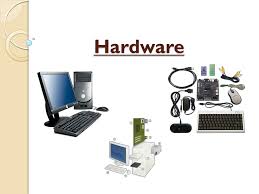
Hardware:
The term “Hardware” refers to the physical elements of a computer; the machinery or the electronics in a computer. A basic computer consists of 4 Input device (or input unit)
Input unit and Output unit
Input unit sends (data) to the computer and output unit presents (information). Input unit: keyboard, mouse, flash drive, etc. Output unit: monitor, printer, speaker, etcInput and output unit or Input and output device (I/O) provide a way to interact with a computer. Some examples of I/O devices are: keyboard used to input text, mouse, touch pad, camera, monitor, speakers, touchscreen for simultaneous input and output.
Examples of hardware (I/O) in a computer are
Keyboard
monitor
Most of a computer’s hardware cannot be seen as it is inside the computer case. Example: Memory, CPU, etc.
Memory Unit
The memory unit is what allows a computer to remember data and information. Similar to human memory, there is short term memory (RAM) and long term memory (Hard Disk Drive (HDD), Solid-State Drive (SSD) or Compact Disk Drive (CDD)).
Examples of hardware (Memory) in a computer are:
-
RAM
-
Hard disk drive
-
Compact disk drive
-
Solid state drive
When a computer is turned off, it forgets everything in the RAM (short term memory), while it saves everything it will need later into a disk drive (long term memory). When data is needed by the CPU, it’s sent from the hard disk drive (HDD) or compact disk drive (CDD) to the RAM. RAM tends to be faster to process, whereas HDD/CDD have more data and require longer to process. CDDs let you change certain parts of the memory, essentially like a book or notebook that you might read and get information from.
- A storage medium gives your computer a place to store data and information that it might need in order to operate. Some things that could be stored in memory might be: text documents, photos, programs, and the operating system (OS).
CPU:
The CPU(or Central Processing Unit) performs arithmetical and logical operations of the computer system.The central processing unit, or processor, is the component of a computer that performs processes. Examples of other tasks performed by the CPU include:
Input/Output directions (reading data from an input device/writing information to an output device) The central processing unit, or processor, is the component of a computer that performs processes. Examples of other tasks performed by the CPU include:
Motherboard:
The motherboard is hardware that makes connections between all of the other components in a computer, effectively telling data where it should go.
Expansion card:
The expansion cards are electronic circuits that add specific ability to a computer systemTypes of Computers
Before looking at the various components, it is useful to distinguish between two different types of computers: desktop computers and laptop computers. A desktop computer consists of a computer case and a separate monitor, keyboard, and mouse. As the name suggests, this type of computer is typically placed on a desk and is not very portable.
| Typical desktop computer with a separate computer case, monitor, keyboard, and mouse |
A laptop computer has the same components but integrated into a single, portable unit.
| Typical laptop computer with integrated hardware components |
While these two types of computers look quite different, they have the same general hardware components.
Hardware Components
Let’s start with the computer case. This is the metal enclosure that contains many of the other hardware components. It comes in various shapes and sizes, but a typical tower model is between 15-25 inches high. Want to know what’s inside? Okay, go get a screwdriver and let’s open it up. Seriously, if you are really into computers, the best way to learn is to actually get hands-on. To save us some time, however, have a look at this desktop computer case. A computer enthusiast replaced the metal side panel with a transparent one, so we can have a look inside.
Although that photo looks pretty cool, it is a bit hard to recognize the individual components, especially with all the connecting wires running through it. This figure shows a more schematic version of a desktop computer, which makes it easier to point out the essential hardware components.
Expansion card
Power supply:
A power supply (power supply unit) is a device that provides electrical energy to the computer system.
Assembled Personal Computer Hardware:
The hardware as assembled with a typical personal computer include
- Monitor
- Motherboard
- CPU (Microprocessor)
- Main memory (RAM)
- Expansion cards
- Power supply unit
- Compact disk drive (CDD)
